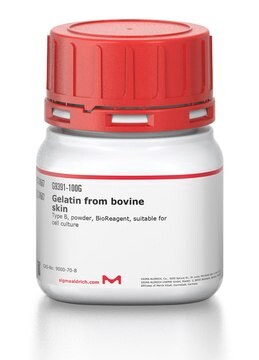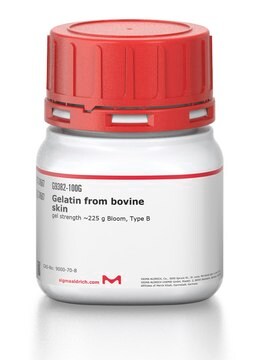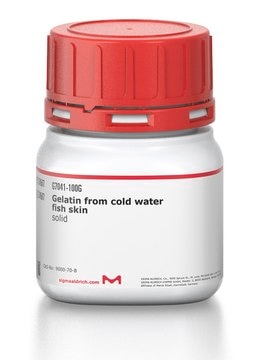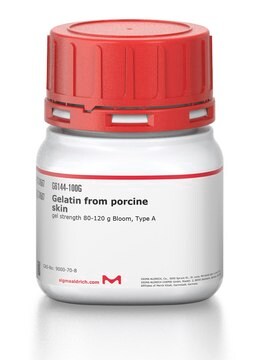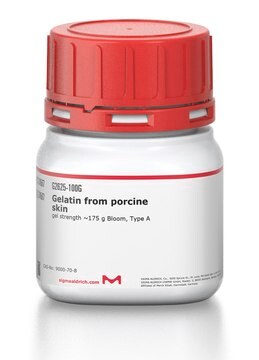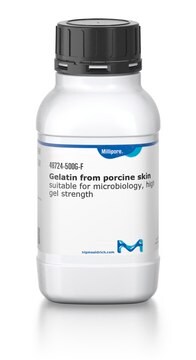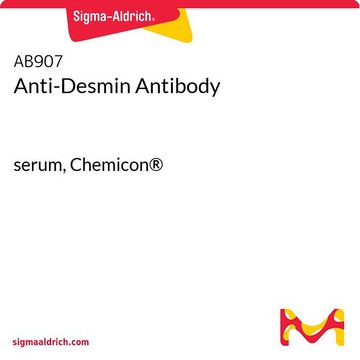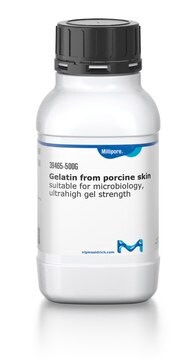Recommended Products
biological source
bovine skin
type
Type B
form
powder
technique(s)
ELISA: suitable
cell culture | mammalian: suitable
immunocytochemistry: suitable
western blot: suitable
Looking for similar products? Visit Product Comparison Guide
Application
Gelatin has various industrial applications such as stabilizer, thickener, and texturizer in foods. It is also used in the manufacture of rubber substitutes, adhesives, cements, lithographic and printing inks, plastic compounds, artificial silk, photographic plates and films, matches, and light filters for mercury lamps. In the pharmaceutical industry, gelatin is used as a suspending agent, encapsulating agent and tablet binder. In veterinary applications it is used as a plasma expander and hemostatic sponge.
This product is recommended for use as a cell culture substratum at 1-5 μg/cm2 or 0.5-50 μg/mL. The optimal concentration does depend on cell type as well as the application and research objectives.
Gelatin was used for coating cell culture to improve attachment of cells, in addition to PCR to help stabilize Taq DNA. It was used as a blocking reagent in Western blotting, ELISA, and immunohistochemistry. Gelatin can also be used as a component of media for species differentiation in bacteriology. Gelatin is a biocompatible polymer and has been used as delivery vehicle for the release of bioactive compounds and in the generation of scaffolds for engineering applications.
It was used to test keratinocyte growth factor stimulation of gelatinase (matrix metalloproteinase-9) and plasminogen activator in histiotypic epithelial cell culture. It was also used to study the changes in the nucleolar organizer regions in the tuberomammillar region after dehydration.
Gelatin was used for coating cell culture to improve attachment of cells, in addition to PCR to help stabilize Taq DNA. It was used as a blocking reagent in Western blotting, ELISA, and immunohistochemistry. Gelatin can also be used as a component of media for species differentiation in bacteriology. Gelatin is a biocompatible polymer and has been used as delivery vehicle for the release of bioactive compounds and in the generation of scaffolds for engineering applications.
It was used to test keratinocyte growth factor stimulation of gelatinase (matrix metalloproteinase-9) and plasminogen activator in histiotypic epithelial cell culture. It was also used to study the changes in the nucleolar organizer regions in the tuberomammillar region after dehydration.
Components
Gelatin is a heterogeneous mixture of water-soluble proteins of high average molecular masses, present in collagen. Proteins are extracted by boiling the relevant skin, tendons, ligaments, bones, etc. in water. Type A gelatin is derived from acid-cured tissue. Type B is derived from lime-cured tissue.
Caution
Dry gelatin, when stored in airtight containers at room temperature, will remain unchanged for many years. When heated at 100°C in the presence of air, it swells becomes soft and disintegrates to a carbonaceous mass with evolution of pyridine bases and ammonia.
Preparation Note
This product is derived from bovine skin. Gelatin is soluble in hot than in cold water. It is practically insoluble in most organic solvents such as alcohol, chloroform, carbon disulfide, carbon tetrachloride, ether, benzene, acetone, and oils. The Bloom number, determined by the Bloom gelometer, is an indication of the strength of a gel formed from a solution of the known concentration. The Bloom number is proportional to the average molecular mass. Bloom numbers of porcine skin Gelatin vary from 90 to 300 g. This product has a gel strength of 50−120.
Storage Class Code
11 - Combustible Solids
WGK
nwg
Flash Point(F)
Not applicable
Flash Point(C)
Not applicable
Personal Protective Equipment
dust mask type N95 (US), Eyeshields, Gloves
Certificates of Analysis (COA)
Search for Certificates of Analysis (COA) by entering the products Lot/Batch Number. Lot and Batch Numbers can be found on a product’s label following the words ‘Lot’ or ‘Batch’.
Already Own This Product?
Find documentation for the products that you have recently purchased in the Document Library.
Customers Also Viewed
PCR Primer
C. Dieffenbach and G. S. Dveksler
PCR Primer: A Laboratory Manual (1955)
E E Putnins et al.
The Journal of investigative dermatology, 104(6), 989-994 (1995-06-01)
The purpose of this investigation was to examine the role that keratinocyte growth factor (KGF) plays in the control of matrix-degrading protease activity in epithelial cells. The culture conditions had a significant effect on cellular responses to the growth factor.
Ziwei Ou et al.
Journal of the American Heart Association, 11(10), e025181-e025181 (2022-05-11)
Background Lung injury, a severe adverse outcome of lipopolysaccharide-induced acute respiratory distress syndrome, is attributed to excessive neutrophil recruitment and effector response. Poldip2 (polymerase δ-interacting protein 2) plays a critical role in regulating endothelial permeability and leukocyte recruitment in acute
Alexandra Murray et al.
Oncology reports, 24(4), 1049-1058 (2010-09-03)
Angiogenesis inhibitors may enhance the effects of low dose (metronomic) chemotherapy. However, there is a wide range of novel angiogenesis inhibitors which must be tested in combinations with oral chemotherapy agents to assess the anti-endothelial and anti-cancer effects. This preliminary
Pavel Khramtsov et al.
Pharmaceutics, 13(10) (2021-10-24)
Gelatin nanoparticles found numerous applications in drug delivery, bioimaging, immunotherapy, and vaccine development as well as in biotechnology and food science. Synthesis of gelatin nanoparticles is usually made by a two-step desolvation method, which, despite providing stable and homogeneous nanoparticles
Our team of scientists has experience in all areas of research including Life Science, Material Science, Chemical Synthesis, Chromatography, Analytical and many others.
Contact Technical Service